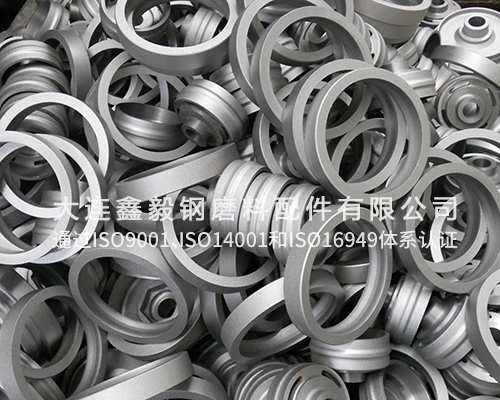Welcome to the official website of Dalian Xinyi steel abrasive parts Co., Ltd!
Dalian Xinyi steel abrasive parts Co., Ltd
Contact: Manager Zhang
Telephone: 0411-39630390
0411-39569620
mobile phone:13795133932
website:en.dlxyg.com.cn
Address: No. 10, Shengsheng Second Road, Dalian Economic and Technological Development Zone
Office worker: Quanshui P3, Ganjingzi District, Dalian
Dalian sandblasting is a common and effective metal surface treatment technology that can improve product surface quality, increase adhesion and corrosion resistance, and is widely used in the production and processing of various metal products. In practical operation, it is necessary to pay attention to selecting appropriate abrasives and controlling processing parameters to ensure that the processing effect meets the expected requirements.
The advantage of sandblasting processing is that it can achieve fast, uniform, and efficient surface treatment, suitable for objects of different shapes and sizes, and can simultaneously perform various treatments such as rust removal, polishing, cleaning, and increasing surface roughness. Sandblasting processing can also improve the adhesion of the workpiece surface, providing a better foundation for subsequent painting, spraying and other processes.
How to ensure the uniformity of abrasive particle size in sandblasting processing in Dalian?
1、 Abrasive procurement and quality control
Choose high-quality suppliers
Select abrasive suppliers with good reputation and quality control system. These suppliers usually adopt advanced production processes and strict quality inspection standards, which can provide abrasives with more uniform particle size. For example, some well-known abrasive production companies use high-precision screening equipment to screen abrasives multiple times to ensure product quality.
View the supplier's product certification and testing reports to understand the standards that the abrasive particle size distribution meets. For example, for abrasives used in precision sandblasting, suppliers are required to provide particle size testing reports that comply with international standards (such as ISO standards) or industry-specific standards.
Incoming inspection
After the abrasive arrives, conduct sampling inspection. Standard sieves can be used for manual screening tests, where abrasive samples are sieved according to different mesh ranges to observe whether the proportion of abrasives within each mesh range meets expectations. For example, for abrasives with a nominal particle size of 80-120 mesh, check for excessive coarse particles (greater than 80 mesh) or fine particles (less than 120 mesh).
Use a particle size analyzer to perform more accurate particle size detection on abrasive samples. This instrument can measure the size distribution of abrasive particles and present it in the form of data and charts. By comparing with the specifications provided by the supplier, determine whether the uniformity of abrasive particle size meets the requirements.
2、 Abrasive storage and management
Reasonable storage environment
Abrasives should be stored in a dry and well ventilated environment. Changes in humidity may cause abrasive clumping, affecting its particle size distribution. For example, in a humid environment, some abrasives containing soluble components may absorb moisture and bond together, making the originally uniform particle size uneven.
Avoid heavy pressure or collision on abrasives to prevent them from breaking and producing fine particles. For bagged abrasives, they should be stacked in the prescribed manner to avoid crushing the bottom layer of abrasives due to excessive stacking.
Classified storage
Classify and store according to factors such as the type and particle size of abrasives. Abrasives of different particle sizes should be stored separately to prevent mixing with each other. Clear labeled storage containers or warehouse areas can be used to distinguish different abrasives. For example, store 20-40 grit abrasives in one area and 40-80 grit abrasives in another area, and clearly label the particle size range, composition, and other information of the abrasives on the container.
Regularly check the condition of the abrasive during storage. If clumping is found, appropriate treatment should be carried out, such as gently crushing the clumped part and re sieving to restore its particle size uniformity.
3、 Abrasive screening and grading
Pre screening equipment
Before using abrasives, pre screen them through a vibrating screen. The mesh size of the vibrating screen should be selected based on the nominal particle size of the abrasive. For example, for 100-150 mesh abrasives, two layers of 80 mesh and 180 mesh screens can be used for screening to remove coarse and fine particles, making the abrasive particles entering the sandblasting equipment more uniform.
For some abrasives that are prone to electrostatic adsorption or agglomeration, anti-static devices or dispersing devices can be added to the screening equipment. For example, when screening plastic abrasives, the plastic is prone to static electricity, which can cause the abrasives to adsorb onto the screen or aggregate with each other. Installing anti-static equipment such as ion air rods can reduce this phenomenon and improve the screening effect.
Fine grading technology
For high-precision sandblasting processing, airflow grading equipment can be used. Airflow classification is based on the difference in suspension velocity of abrasive particles in the airflow. By precisely controlling the airflow velocity and the parameters of the grading area, abrasives can be classified into grades with a narrower particle size range. For example, the abrasive originally with a particle size of 60-100 mesh can be further subdivided into several grades such as 60-70 mesh, 70-80 mesh, 80-90 mesh, and 90-100 mesh to meet different sandblasting requirements.
Centrifugal grading is also an effective abrasive grading method. Abrasives in a high-speed rotating centrifugal field experience different centrifugal forces based on particle size and density, thus achieving classification. This method can handle large quantities of abrasives and obtain products with good particle size uniformity.
4、 Control measures in sandblasting equipment
Abrasive conveying system protection
Install a filter or screen in the abrasive conveying pipeline to prevent small amounts of coarse particles or foreign objects generated during storage and transportation from entering the spray gun. The mesh size of the filter should be selected according to the particle size of the abrasive, generally smaller than the minimum particle size of the abrasive, to ensure effective interception of impurities. For example, for abrasives with a grit of 120-180 mesh, a 200 mesh filter can be selected in the conveying pipeline to ensure particle size uniformity before the abrasive enters the spray gun.
Regularly clean the residual abrasives inside the conveying pipelines and equipment. Residual abrasives may break or clump during equipment operation, affecting the particle size uniformity of newly added abrasives. Compressed air blowing or mechanical cleaning can be used to ensure the cleanliness inside the equipment.
Spray gun design and adjustment
Choose a suitable spray gun nozzle design, some nozzles have special flow guiding structures inside, which can make the abrasive spray more evenly. For example, a nozzle with a spiral guide groove can provide more stable velocity and distribution of abrasive during spraying, reducing the differences in abrasive particle size selection caused by uneven spraying.
Adjust the working parameters of the spray gun according to the abrasive particle size. For abrasives with smaller particle sizes, it is advisable to reduce the spray pressure and abrasive flow rate appropriately to avoid abrasive breakage or uneven dispersion during the spraying process. For abrasives with larger particle sizes, the spray pressure can be appropriately increased, but attention should also be paid to preventing excessive splashing of abrasives that may affect the processing quality and uniformity.
Sandblasting is a surface treatment technique that uses high-pressure abrasive spraying to rub the abrasive against the surface of the object being treated, thereby achieving the effect of removing surface dirt, oxide layers, and coatings. Sandblasting processing is widely used for surface treatment and roughening of materials such as metals, plastics, ceramics, and glass.
In the mechanical manufacturing industry, sandblasting is used to remove oxide scale, rust, and oil stains from the surface of metal workpieces (such as mechanical parts, molds, forgings, etc.), preparing for subsequent painting, electroplating, heat treatment, and other processes. For example, in the manufacturing of automotive parts, the engine cylinder block needs to be sandblasted before painting to improve the adhesion of the paint film, make the coating more firm, and extend the service life of the parts.

![]()
Office address: P3 Quanshui District, Ganjingzi District, Dalian
Factory address: No. 10, Shengsheng Second Road, Dalian Economic and Technological Development Zone
Copyright © http://en.dlxyg.com.cn/ 大连鑫毅钢磨料配件有限公司 Specializing inDalian sandblasting,Dalian shot blasting,Dalian blackened surface treatment,Welcome to inquire!
辽ICP备18004327号 Powered by Clouds platform Technical Support:Joint enterprise Era
 | Wechat scan Pay attention to our timely information |